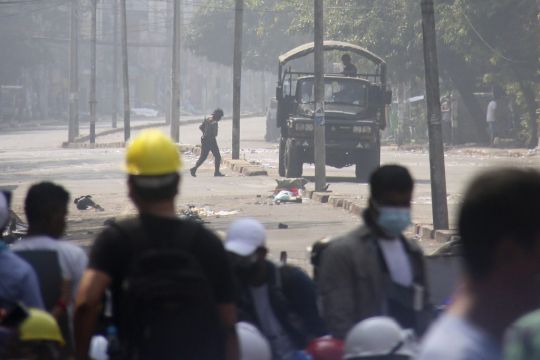Police in Myanmar have repeatedly used tear gas and rubber bullets against crowds protesting against last month’s coup, but the demonstrators regrouped after each volley and tried to defend themselves with barricades as standoffs between protesters and security forces intensified.
Authorities have escalated their crackdown on the protests in recent days, making mass arrests and firing into crowds.
The United Nations said it believed at least 18 people were killed on Sunday by security forces, and foreign ministers from south-east Asian countries were meeting on Tuesday to discuss the crisis.
Despite the crackdown, demonstrators continued to flood the streets — and are beginning to more rigorously resist attempts to disperse them.

Hundreds, many wearing construction helmets and carrying makeshift shields, gathered in Myanmar’s largest city of Yangon, where a day earlier police had fired repeated rounds of tear gas.
They dragged bamboo poles and debris to form barricades, chanted slogans and sang songs at the police lines. They even threw banana skins on to the road in front of officers in a bid to slow any police rush.
The mainly young demonstrators fled each time tear gas canisters were fired but soon returned to their barricades. Videos posted on social media showed similar scenes in the Insein neighbourhood of northern Yangon.
Protesters also took up their flags and banners to march through the streets of Dawei, a small city in south-eastern Myanmar which has seen almost daily large demonstrations against the coup.

One group of demonstrators was targeted by security forces as it entered a narrow street on its way to pay respects at the house of a man killed in Sunday’s crackdown. Another was attacked on the main street in the city’s centre.
Police also dispersed protests in Mandalay, the country’s second-largest city, on Tuesday.
Yangon, Dawei and Mandalay were among the cities where security forces reportedly fired live ammunition into crowds on Sunday, according to the UN Human Rights Office. There were reports that they also fired live rounds on Tuesday, but they could not immediately be confirmed.
Some fear the junta’s escalating use of force is meant to provoke a violent backlash by largely non-violent demonstrators to discredit them and justify an even harsher crackdown. Videos from recent days show a greater number of protesters trying to stand their ground and throw objects at the police.

The February 1 coup reversed years of slow progress towards democracy in Myanmar after five decades of military rule. It came the day a newly elected parliament was supposed to take office.
Ousted leader Aung San Suu Kyi’s National League for Democracy party would have been installed for a second five-year term, but instead she was detained along with President Win Myint and other senior officials.
The military government has charged Ms Suu Kyi, 75, with several offences that critics say are trumped up to keep her jailed and potentially prevent her from participating in the election promised in a year’s time by the military.
Her party says it does not know where Ms Suu Kyi — who has a long history of campaigning for democracy in Myanmar — is being held.







